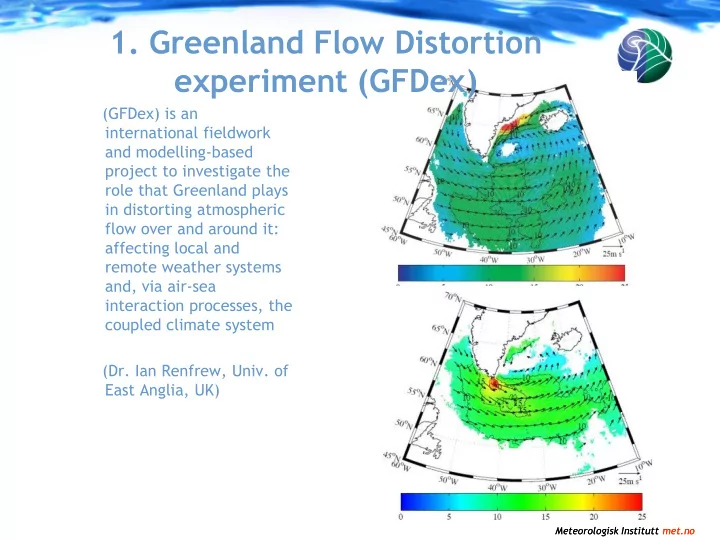

1. Greenland Flow Distortion experiment (GFDex) (GFDex) is an international fieldwork and modelling-based project to investigate the role that Greenland plays in distorting atmospheric flow over and around it: affecting local and remote weather systems and, via air-sea interaction processes, the coupled climate system (Dr. Ian Renfrew, Univ. of East Anglia, UK) Meteorologisk Institutt met.no Meteorologisk Institutt met.no
2. Storm Studies of the Arctic STAR • Enhanced surface, radar, upper-air observations in eastern Canadian Arctic • Gap flow, interaction of cyclones with topography and air- sea-ice interactions. • Air-sea-ice interactions, orographic precipitation and ice cores. • Over the eastern Canadian Arctic and adjoining seas. Will work with Inuit to incorporate findings for use by local communities. Aircraft, surface and ship-based field campaign in southern Baffin Island; September-October 2007. Flight-level meteorology, cloud physics, broadband radiation, turbulence, as well as profiles from dropsondes John Hanesiak, University of Manitoba, Canada Meteorologisk Institutt met.no Meteorologisk Institutt met.no
3. Concordiasi Validate and improve the assimilation of AIRS/IASI in numerical models. (Florence Rabier, MeteoFrance) Meteorologisk Institutt met.no Meteorologisk Institutt met.no
4. THORPEX-IPY-Norway • DLR Falcon from Andenes • Satellites; IASI instrument • New radiosonde at Franz Josef Land • Added radiosondes at Bear Island, Kola peninsula, Ny Ålesund • Tethered balloon system at Ny- Ålesund • Weather balloons from Coast Guard ships • AMDAR onboard commercial aircraft • Weather radar Andøya • Drifting buoys ? • NOAA P-3 aircraft ? • Flux mast Svalbard ? • Radiation measurements ? (Jón Egill Kristjánsson, University of Oslo) Meteorologisk Institutt met.no Meteorologisk Institutt met.no
5. TAWEPI TAWEPI’s Polar -Gem (The Arctic Weather and Environment Prediction Initiative) • An important component of this proposal is to develop a regional Numerical Weather Prediction (NWP) system (10-15km horizontal resolution) over the Arctic in support of the IPY projects, like THORPEX and field measurement campaigns. • EXPECTED ADVANCES: - Improvement of environmental forecasting from a few hours to two days for warning, health, transport, planning and security. - Unprecedented high resolution time series of analyses of environmental parameters for miscellaneous studies (impact, adaptation, health, …) (Dr. Gilbert Brunet, Proposal Leader, Meteorological Research Division, Canada) Meteorologisk Institutt met.no Meteorologisk Institutt met.no
6. Greenland Jets 27 July 2002 1425 UTC (MODIS Terra (Dr. Andreas Dörnbrack, DLR, Germany ) (Andreas Dörnbrack, DLR Germany) Meteorologisk Institutt met.no Meteorologisk Institutt met.no
7. GREENEX • Conceptual model of atmospheric response to orography leading to downstream development. Forecasting of small- scale weather phenomena, including extremes. • Meso- and fine-scale flows in the vicinity of orography and sea ice and downstream weather development. Scale interactions. • Over the N-Atlantic, Europe and globally. Automatic meteorological high-temporal resolution ground observations in Iceland. Flights associated with DLR, Germany and Univ. East Anglia, UK. (Haraldur Ólafsson, University of Iceland) Meteorologisk Institutt met.no Meteorologisk Institutt met.no
8. Arctic Regional Climate Model Intercomparison project ARCMIP and CARCMIP Participating models: 1. ARCSyM (USA) 2. COAMPS (S,USA) 3. HIRHAM (D,DK) 4. CRCM (CAN) 5. RCA (S) 6. RegCM (N) 7. REMO (D) 8. PolarMM5 (USA) 1-year simulations (Sep.97 – (Klaus Dethloff, Alfred-Wegener Institute for Sep.98) for a small domain Polar and Marine Research Unit Potsdam) (SHEBA domain) 10-year simulations (1990 – SHEBA = Surface Heat Budget of the Arctic Ocean 2000) for a pan-Arctic domain within GLIMPSE – Green: Trajectory of the SHEBA ice camp in the Beaufort-Chukchi sea (1997 – 1998) Meteorologisk Institutt met.no Meteorologisk Institutt met.no
9. Impacts of Surface Fluxes on Severe Arctic Storms, Climate Change and Arctic Coastal Oceanographic Processes Change in Arctic Storms climate – Zhang et al. 2004 J. Climate (Will Perrie, Bedford Institute of Oceanography, Canada ) Meteorologisk Institutt met.no Meteorologisk Institutt met.no
10. THORPEX Pacific Asian Regional Campaign (T-PARC) • The goals of T-PARC are to increase the understanding of factors that limit our ability to predict both high-impact weather over the densely populated regions of East Asia’s Pacific Rim and the downstream effects of these processes on weather events over North America A major international research campaign will have field phase in 2008. (David Parsons, NCAR) Meteorologisk Institutt met.no Meteorologisk Institutt met.no
Recommend
More recommend